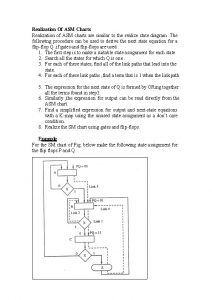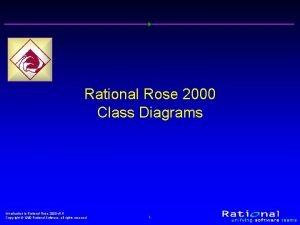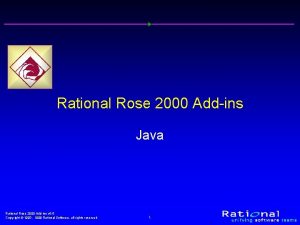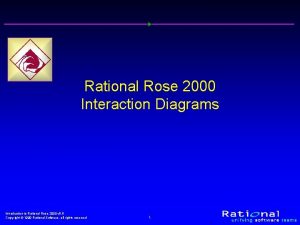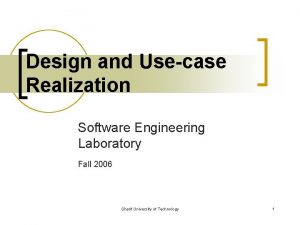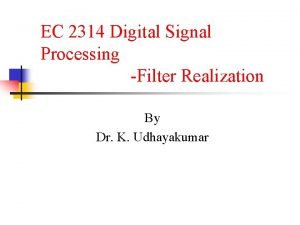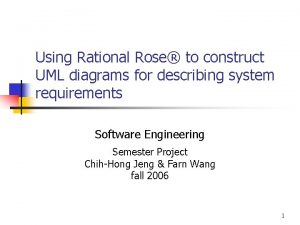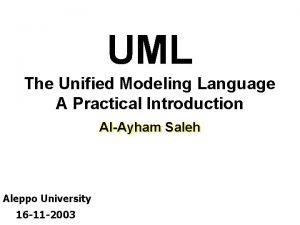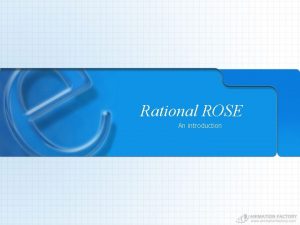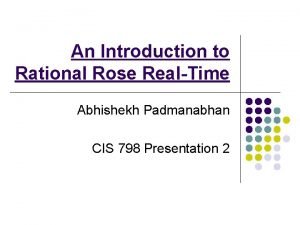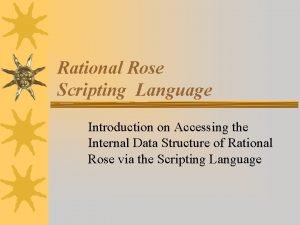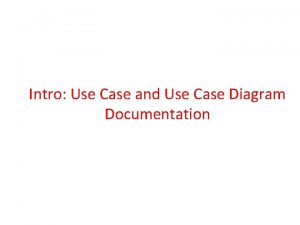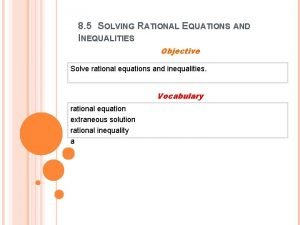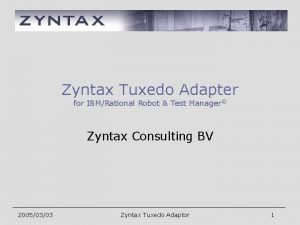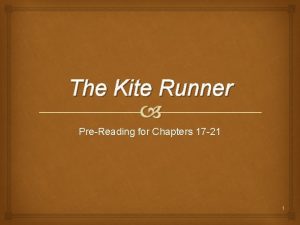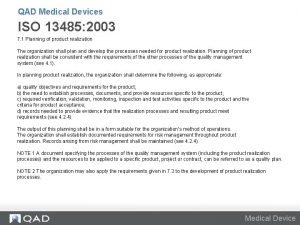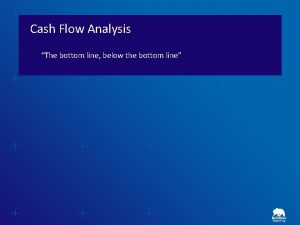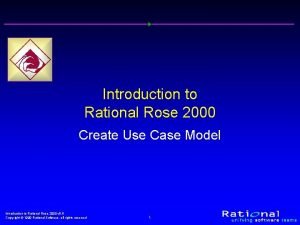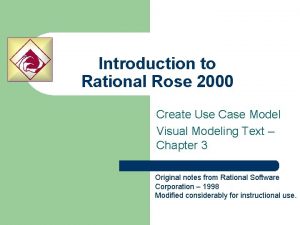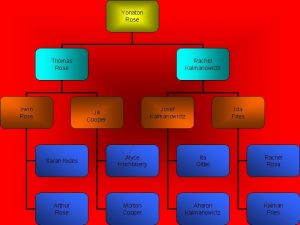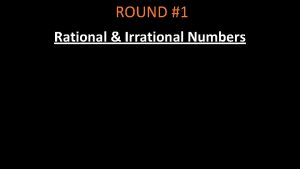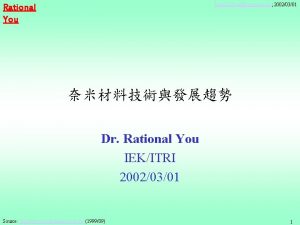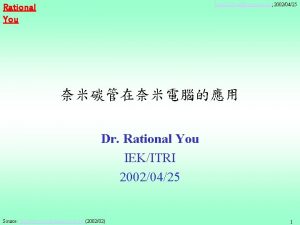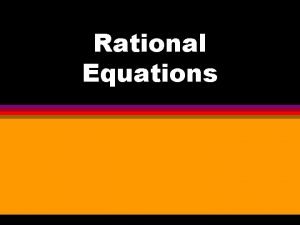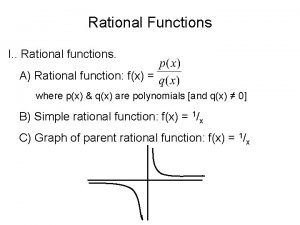Rational Rose 2000 Use Case Realization Structure Introduction






















- Slides: 22

Rational Rose 2000 Use Case Realization Structure Introduction to Rational Rose 2000 v 6. 5 Copyright © 1999 Rational Software, all rights reserved 1

Objectives w Discuss what a Use Case Realization is. w Define when the use case realizations are created. w Create Use Case Realization structure in Logical View. § Create a Use Case Realizations package § Create Individual use case realization packages § Create a Traceabilities diagram Introduction to Rational Rose 2000 v 6. 5 Copyright © 1999 Rational Software, all rights reserved 2

Where Are We? Interaction diagrams are created and refined during the elaboration phase of this workflow for architecturally significant use cases, along with class diagrams (not to be confused with analysis classes…)and the flow of events. Interaction diagrams for remaining use cases are created during the Construction phase of this workflow. Introduction to Rational Rose 2000 v 6. 5 Copyright © 1999 Rational Software, all rights reserved 3

Where Are We? The Use Case Realization structure is created during architectural analysis. This may be skipped if there is low architectural risk, or the architect is experiences in the domain. If so, use case realization is begun during use case analysis. Input Artifacts: Use Cases developed during Requirements Workflow and those refined during the Analysis and Design Workflow. Introduction to Rational Rose 2000 v 6. 5 Copyright © 1999 Rational Software, all rights reserved 4

Use Case Realizations w “Use Case Realizations” is a term used in the Rational Unified Process. w In particular, they are captured in the Logical View (Design Model) (think: 4+1 architectural view). w Purpose of a Use Case Realization § separate the concerns of the specifiers of the system (as represented by the Use Case Model and the requirements of the system) from the concerns of the designers of the system. w A Use Case Realization represents the design perspective of a Use Case. w It is a collaboration of components that realizes (or performs) some use case. w The realization describes how the behavior of a use case is performed by the collaboration of elements (classes, …) within the system. Introduction to Rational Rose 2000 v 6. 5 Copyright © 1999 Rational Software, all rights reserved 5

Use Case Realizations w Main purpose is to provide a bridge between the descriptions of the system used by external stakeholders (principally users and customers), such as use cases and requirements, and the descriptions of the system used by the internal stakeholders (principally developers and testers. ) w Use case realizations overcome a problem area that is key in many other development techniques – the discontinuity between requirements and design. w They provide for traceability! Introduction to Rational Rose 2000 v 6. 5 Copyright © 1999 Rational Software, all rights reserved 6

Use Case Realizations w The separation of the use-case realization from the use case is essential as it decouples the use case from its implementation, allowing the design to progress without affecting the baseline requirements captured in the use case. w Typically, for each use case in the use case model, there will be a use case realization in the design model (in logical view ) with a realization relationship to the use case. w Typically there is at least one test case for every use-case realization (scenario-based) Introduction to Rational Rose 2000 v 6. 5 Copyright © 1999 Rational Software, all rights reserved 7

Use Case Realizations w Use Case realizations can be expressed visually using UML constructs such as sequence and collaboration diagrams OR textually using structured English. § In fact, when people write their use cases with an implementation focus, discussing the components of the system and the way that they work, they are actually creating a textual use-case realization rather than a use–case description. Introduction to Rational Rose 2000 v 6. 5 Copyright © 1999 Rational Software, all rights reserved 8

Compare: w Strength of Use Cases § Communicate with end user in • Language of the end user / stakeholders • Problem space w Weaknesses of Use Cases § Not formal § Fuzziness in places Introduction to Rational Rose 2000 v 6. 5 Copyright © 1999 Rational Software, all rights reserved 9

Key Concepts w Use case realizations and the Logical View § Represent the concerns of the system’s designers Thus, created during the Logical View. (RUP) (analysis and design) § Moved from concerns of the end user to that of the system designer. § The Logical View addresses the functional requirements of the system. The Use Case View is used to communicate with the end user or customer. w Use case realization packages § Packages help organize the model and vital for using Rose – distribution of functions, work assignments, distribution, etc. • We will create a package called Use Case Realizations and in it create packages for each use case realization. w Traceabilities diagram § Created in the Use Case Realizations package to help verify that the use cases (from use case view) are represented in the design model via use case realizations. Introduction to Rational Rose 2000 v 6. 5 Copyright © 1999 Rational Software, all rights reserved 10

Use Case Realization - Practicuum w Objectives § Create the use realization structure in the Logical View. § Create the Traceabilities diagram. Introduction to Rational Rose 2000 v 6. 5 Copyright © 1999 Rational Software, all rights reserved 11

Add Package Called Use Case Realizations Bring up your model in Rose In Browser, expand Logical View Right Click Logical View then click New Click Package. Type Use Case Realizations over New. Package, then click off Leave model open. Now, will create use case realization packages for each use case. . Use Case Realizations package added Depending on your version of RR, you may need to expand the Design Model after you right click on Logical View. I did not have to on mine… Introduction to Rational Rose 2000 v 6. 5 Copyright © 1999 Rational Software, all rights reserved 12

Add Three Use Case Realization Packages Use case realization packages added under Use Case Realizations In book example: Add three use case realization packages. Right Click Use Case Realizations, New, Package, Type Use Case Realization – Register for Courses over New. Package. Repeat steps 1 – 3 to add Use Case Realization - Login and Use Case Realization – Close Registration. Leave model open. Let’s create a Traceabilities Diagram. Introduction to Rational Rose 2000 v 6. 5 Copyright © 1999 Rational Software, all rights reserved 13

Create Traceabilities Diagram In the browser, the Traceabilities diagram added under Use Case Realizations package Right click Use Case Realizations; click New; Click Use Case Diagram; Type ‘Traceabilities’ over New Diagram. Double-click the Traceabilities diagram. The Use Case Diagram window is displayed. (We will model the Realizations… In the browser, expand the Use Case View Introduction to Rational Rose 2000 v 6. 5 Copyright © 1999 Rational Software, all rights reserved 14

Create Traceabilities Diagram Use case realization Use case Namespace warning • Add your Use Cases to the diagram from your Use Case View. • Drag those Use Cases onto the diagram; Repeat for all use cases in the UC View • Add the Use Case realizations… From the toolbar, select a Use Case icon and place it on the diagram. Right click to get the Open Specification; type in the name; and in the stereotype list select Use-case realization. Then, OK. (Ignore namespace warning) (You will note the appearance of the oval) Continue until all use cases have their realizations on the same diagram. Introduction to Rational Rose 2000 v 6. 5 Copyright © 1999 Rational Software, all rights reserved 15

Create Traceabilities Diagram Before continuing with the Traceability diagram, this is what we have. Use case realizations added in browser Introduction to Rational Rose 2000 v 6. 5 Copyright © 1999 Rational Software, all rights reserved 16

Create Traceabilities Diagram Use case realization moved its package Collapse the Use Case View. (Done with this at this time…) In the browser, drag the use case realizations under their respective packages as shown to the right. Repeat this for all Use Case Realizations. (Relocate them in their packages) Back to the Traceabilities Diagam Introduction to Rational Rose 2000 v 6. 5 Copyright © 1999 Rational Software, all rights reserved 17

Continuing to Create Traceabilities Diagram The Traceability Diagram we have is: Use case realization identified with its package Introduction to Rational Rose 2000 v 6. 5 Copyright © 1999 Rational Software, all rights reserved 18

Continuing Traceabilities Diagram Stereotype added Unidirectional association added ------------------Add the unidirectional associations via the toolbar Drag the mouse from the Use Case realization icon to the Use Case. Repeat for all Use Case Realizations. Double click on the association line. In the stereotype list box enter ‘realizes. ’ Introduction to Rational Rose 2000 v 6. 5 Copyright © 1999 Rational Software, all rights reserved 19

Traceability Diagram w Now that we’ve set up our use case realization structure and created a Traceabilities diagram, we can create our interaction diagrams. w Before doing this, let’s review preferred practices. Introduction to Rational Rose 2000 v 6. 5 Copyright © 1999 Rational Software, all rights reserved 20

Preferred Practices w Create a package called Use Case Realizations in the Logical View. § (Each Use Case Realization is itself inside of the Use Case Realizations Package in the Design Model in the Logical View. ) w Create a diagram called Traceabilities under Use Case Realizations package. w Create packages under Use Case Realizations for each use case. w Name each package the same as its use case. Introduction to Rational Rose 2000 v 6. 5 Copyright © 1999 Rational Software, all rights reserved 21

Introduction to Rational Rose 2000 v 6. 5 Copyright © 1999 Rational Software, all rights reserved 22
 Asm chart
Asm chart Vopc diagram
Vopc diagram Rational rose 2000
Rational rose 2000 Rational rose 2000
Rational rose 2000 Usecase realization
Usecase realization Use case realization
Use case realization Use case realization
Use case realization Digital signal processing
Digital signal processing Best case worst case average case
Best case worst case average case Rational rose diagram
Rational rose diagram Rational rose
Rational rose What is rational rose
What is rational rose Rational rose
Rational rose Rational rose
Rational rose Rational rose tutorial
Rational rose tutorial Introduction to use case diagram
Introduction to use case diagram Solving rational equations and inequalities
Solving rational equations and inequalities Tux robot
Tux robot Touching spirit bear chapter 20 questions and answers
Touching spirit bear chapter 20 questions and answers Farzana kite runner
Farzana kite runner Iso 13485 product realization
Iso 13485 product realization Self realization aristotle
Self realization aristotle Cash realization ratio
Cash realization ratio
